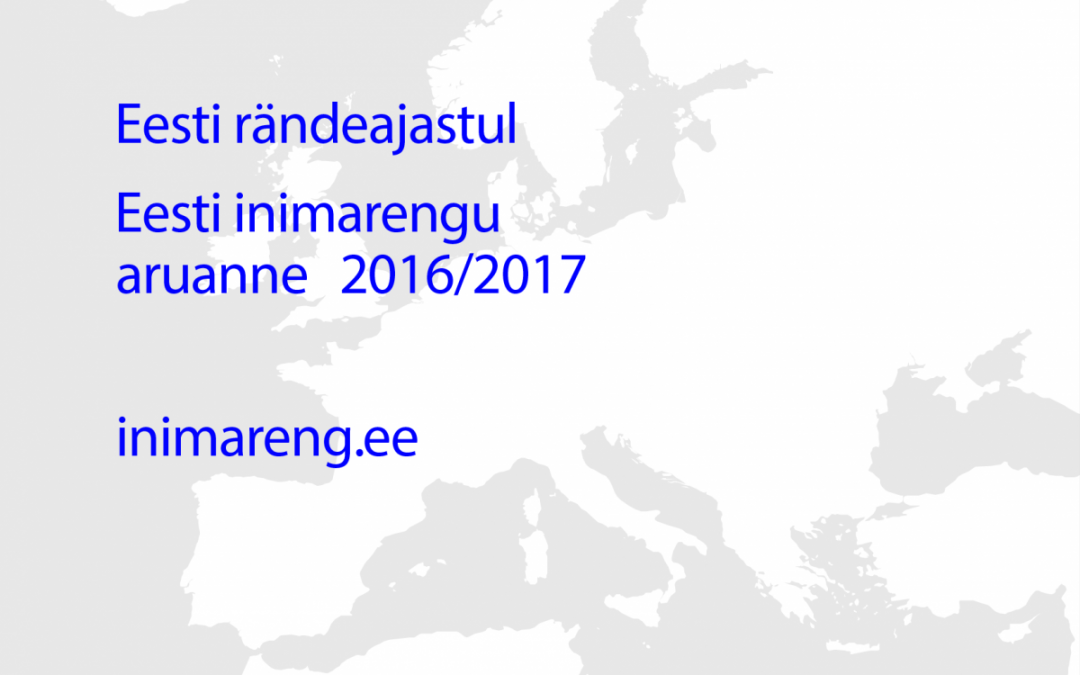The main message of the Human Development Report to be introduced today in Riigikogu is that Estonia’s size of population will not be maintained without migration.
Hence, Estonia has to decide whether we want to manage migration in a favourable way for us or merely respond to self-forming immigration.
In the opinion of the authors, Estonia needs a proactive policy on how to solve the fall in the the size of its population, migration issues and integration problems.
The Estonian Cooperation Assembly today introduces the Human Development Report 2016/2017, entitled “Estonia at the Age of Migration”. The report produced by Tiit Tammaru, editor-in-chief, Professor of Urban and Population Geography at the University of Tartu and 40 authors is concentrated on the influences of new migration era, trans-nationality, cohesion in society, the future existence of the Estonia’s population, and language and culture.
According to the authors of the report, Estonia, along with the rest of the world, is about to step into a new migration era that is characterised by an increase in the migration of people and a change in the essence of migration. The migration that is coming about in the world has one clear characteristic – an inclination towards welfare. In Estonia, the growth of welfare being measured by human development index has been one of the biggest in Europe in the last 25 years; as a result of this, Estonia is becoming attractive for immigrants. At the same time, the interest of employers in the recruitment of external staff has also grown substantially. The authors call the described situation ‘migration reverse’. The circumstance that not all of Estonia’s people, especially residents of peripheries and unskilled blue-collar workers, do not get a sufficient portion of the increase in welfare causes continuous emigration to Finland and other EU Member States. At the same time, immigration has also grown through an increase in general welfare, especially from outside of the European Union. In 2015, for the first time within the last 25 years, the number of arrivals in Estonia surpassed the number of people leaving from Estonia. If the prevalence of emigration and the low birth-rate continue, then, pursuant to the population prognosis of the Human Development Report, Estonia’s population size would be less than 800,000 people by the end of the 21st century. The report reached the conclusion that Estonia’s population size would grow only on the condition that every woman would give birth to at least two children in the next 30 years and about 200,000 immigrants would come to reside in Estonia. In order to reproduce the number of population, it is necessary to contribute to family as well as migration policy. Estonia has become dependent on migration or; in other words, it is not possible to retain today’s population level simply by means of increasing the birth rate. The fostering of immigration is also necessary. The authors of the report propose to prepare the migration strategy in order to work thoroughly through the main migration policy related objectives of the state. The report also reaches the conclusion that the social link between the Estonian-speaking and Russian-speaking communities is still weak. One of the reasons for this is the persistent language-based separated kindergarten and school system that divides children into parallel worlds based on the Estonian and Russian languages. The European experience shows that in a situation where immigrants are over-represented among blue-collar workers and have tended to live tin cheaper urban areas, social problems cannot be avoided if poverty and nationality coincide. The authors are of the opinion that in the present conditions of newly growing immigration, it is time for Estonia to take decisive steps towards connecting language and nation based parallel societies. Kindergarten and school are these institutions by agency of which it would be possible to initiate changes, and this must be done.
A separate chapter in the report deals with modern trans-nationality or the situation where the territories of the countries, places of residence of citizens or activity spaces of people do not overlap in an ever more open world. The same concerns Estonia where mutually closely communicating communities, enterprises and people are located in their homeland as well as abroad. It means that the question of to whom belong the people living in multinational world in sense of political, citizenship, taxation or social security must be solved. How much property should be owned or taxes paid in a homeland, winter home or country of work, to be eligible for example, to the right to vote? Taking into account all the above-said, the authors of the Human Development Report propose to develop a migration and human resources strategy for Estonia.
The Human Development Report “Estonia at the Age of Migration” is in full online in English https://inimareng.ee/en.
Contacts:
Teele Pehk
Estonian Cooperation Assembly CEO
teele.pehk@kogu.ee
+372 58 100 478
Tiit Tammaru
„Estonia at the Age of Migration” editor-in-chief
tiit.tammaru@ut.ee
+372 5 057 331
Press info:
Helin Vaher
53 408 556
helin.vaher@agendapr.ee
